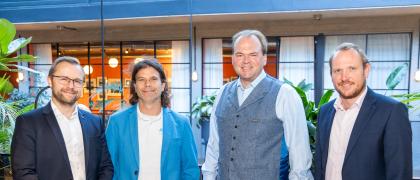
E-Mobility Talk: E-mobility is in no way inferior to combustion engines
Growing charging infrastructure and long-lasting batteries are jointly changing e-mobility behavior. The charging process is getting closer to conventional refueling due to the increasing charging speed. Long distances can also be easily covered electrically and careful recycling of e-car batteries contributes to greater sustainability and circularity.
At the 5th E-Mobility Talk on October 15, 2024, SMATRICS invited experts to discuss the development of charging power and batteries for electrically powered vehicles. Represented were (from left to right):
- Marcus Jahn, Unit Leader Battery Technologies at AIT Austrian Institute of Technology
- Nikolaus Mayerhofer, Founder & CTO AVILOO Battery Diagnostics
- Hauke Hinrichs, CEO SMATRICS
- Thomas Haid, Managing Director Saubermacher Battery Services GmbH
Charging power as the tip of the scales
Two aspects are crucial for the success of e-mobility: the duration of charging and the durability of the battery. Charging technology in particular has developed significantly over the past ten years. SMATRICS launched its 22-kilowatt AC charging infrastructure in 2012. The first DC chargers were installed just two years later and the first high-power charging stations with 150 kilowatts in 2018.
The increasing charging speed is bringing the charging process even closer to conventional refueling. It is already possible to charge for 100 km in five minutes. Hauke Hinrichs, CEO of SMATRICS, explains: “To cover a long distance of 400 kilometers, you need a stopover of 15 minutes. With e-mobility, we already have an equivalent replacement for combustion engines.”
90 percent battery power even after 100,000 km
With the growing share of e-vehicles, the used e-car market is also growing. Objective analysis and evaluation of the e-car battery, such as with the battery tests from the Austrian company AVILOO, is becoming increasingly important. Nikolaus Mayerhofer, Founder & CTO AVILOO Battery Diagnostics, makes a comparison: “It makes a difference whether I measure my blood pressure myself or have a health check including an ECG done by a doctor.”
In addition to the general health of the battery, the tests also analyze and highlight other aspects such as safety, anomalies and faults. Evaluations of more than 50,000 batteries have shown that battery performance can still be 90 to 100 percent even after 100,000 km of driving. The type of charging - whether fast or slow - can influence the service life of the battery.
Your own driving behavior and parking the vehicle also have a strong influence: moderate driving behavior protects the battery, while nervous driving or driving “with a lead foot” causes it to age much faster. Parking with a high charge level also has an unfavorable effect on battery life. “Customers are therefore in control of how long their e-car battery lasts,” says Mayerhofer.
Driving battery development forward in Europe
The development of a new battery technology from laboratory to application takes an average of ten to 19 years. “The scaling process from the laboratory to market maturity is particularly challenging. Third-generation batteries, so-called lithium-ion batteries, are currently in use,” says Marcus Jahn, Unit Leader Battery Technologies at AIT Austrian Institute of Technology.
Currently, 80 percent of battery production takes place in Asia, and Europe has some catching up to do. Global production of one terawatt hour is forecast for 2028, which is almost double the figure for 2023. The decisive factors in battery development are range, charging time, costs, safety, durability and environmental compatibility.
Among the new battery technologies currently under development is the so-called solid-state battery. The advantages of these are that they are safer and require less cooling. According to Jahn, battery research must also take into account that production processes must be made greener, a subsequent recycling process must already be considered in the design and alternative materials must be used to replace critical raw materials.
Recycle and reuse
Around 180,000 battery electric vehicles are currently registered in Austria. Around 3,000 new vehicles are added every month. Saubermacher Battery Services GmbH supports the handling of e-car batteries. The services offered range from consulting services and the provision of special equipment to professional collection and legally compliant, sustainable recycling. The aim is to close the cycle.
At the Premstätten site in Styria, several hundred tons of batteries are currently accepted and treated, including around 50 tons of battery packs. These are deeply discharged and dismantled so that they can then be recycled in the best possible way. Discharging takes up to ten hours, manual dismantling another five. The batteries, sorted by type and chemical composition, are then handed over to European specialist companies for further processing.
“It is crucial that the critical raw materials are recycled and remain in Europe,” emphasizes Thomas Haid, Managing Director of Saubermacher Battery Services GmbH. Currently, up to 70 percent of the total battery mass is recycled, and up to 95 percent of the metals contained can be recycled.
Next steps in charging capacity
The charging capacity of electric cars currently covers demand well. In the next few years, the masses will get by with 200 to 300 kW charging power for electric cars. Larger development steps are expected in the charging capacity for e-trucks - with so-called megawatt charging systems for up to 3.15 megawatts of charging capacity.
SMATRICS will start the first pilot projects next year, with a roll-out of this charging infrastructure planned from 2026. The charging infrastructure along the highways in Austria is also already very well developed. Hinrichs: “Now we need to make the cities and towns where there are fewer opportunities for home charging fit for e-mobility.” The proportion of fast charging points - i.e. DC and HPC charging points - is increasing much faster than the proportion of AC charging points, especially in urban areas.
Further information